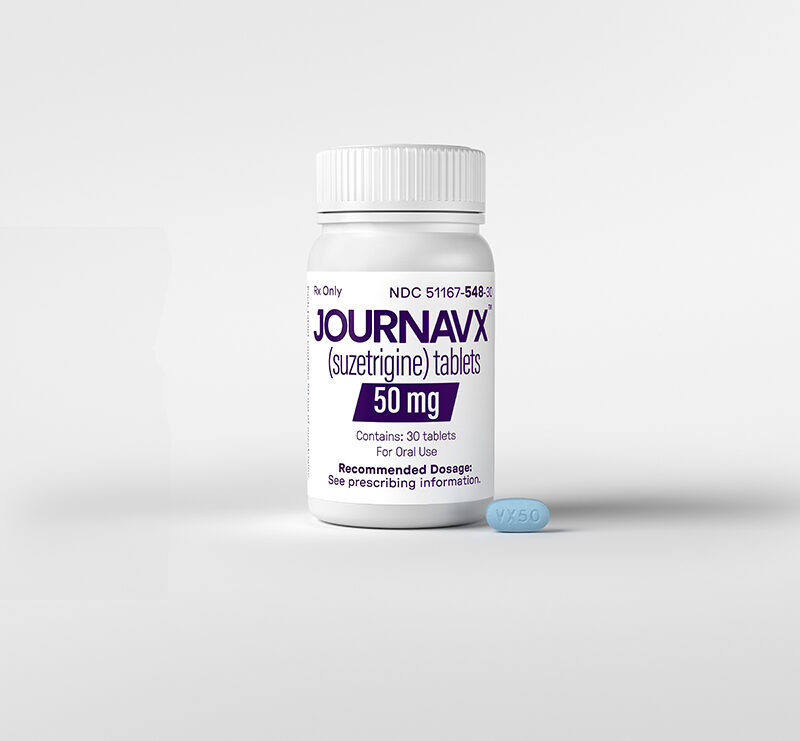Pictured: JOURNAVX bottle and tablet (Photo: Business Wire)
The Jan. 30 approval of Vertex Pharmaceuticals’ JOURNAVX™ (suzetrigine), for acute pain, represents a watershed in the decades-old quest for non-addictive pain relief and a victory in the war against the opioid epidemic.
The first new class of pain medicine approved by the Food and Drug Administration (FDA) in more than 20 years, JOURNAVX inhibits pain signals in part of the nervous system called the NaV1.8 voltage-gated sodium channel.
Now that the solution has been discovered, it sounds straightforward:
“Because JOURNAVX blocks pain signals only found in the periphery, not in the brain, JOURNAVX provides effective relief of pain without the limitations of currently available therapies, including the addictive potential of opioids,” Vertex explains.
But figuring out how the pain traveled to the brain, and how to stop it, was a challenge that many teams of researchers had worked on for years.
The advances by Vertex were made possible through the discovery of a mutation that blocks electric transmission of pain signals. Other companies have been using this discovery, or pursuing other avenues for addressing pain without opioids, which means this first approval in decades may soon be followed by several others.
The need for alternative pain treatments
Stopping the epidemic of deaths from opioid abuse has been a priority of the first and second Trump Administrations. The use and abuse of opioids goes back much further.
The earliest prescription for an opioid was found in an 8,000-year-old hardened Sumerian clay tablet, and its modern use as a pain treatment began with the invention of morphine in 1805, but the dangers of opioid addiction have been known for millennia, according to neurology.org.
In the 1990s, there was a rash of overprescription of opioids due to aggressive marketing that left many who had sought pain treatment with severe addictions, according to the National Institutes of Health (NIH). Subsequent efforts to reduce prescription of opioids created a new problem as people who had become addicted sought illegal opioids, increasing chances of overdose.
Despite the dangers, there is a need for drugs to treat pain. Of the 80 million Americans receiving a prescription for acute pain annually, many receive an opioid because there are few alternatives, and tens of thousands end up developing an opioid addiction, according to Vertex.
By the time President Trump declared opioids a national health crisis in October 2017, the epidemic in the U.S. was claiming close to 50,000 lives a year, according to the Centers for Disease Control and Prevention. The number of U.S. opioid deaths peaked at 84,181 in 2022, but is still high, CDC says.
Trump has made combatting the opioid epidemic a priority of his second administration and imposed tariffs on China, saying they had not done enough to stop synthetic opioids from entering the U.S. illegally.
Science, policy and market challenges
Researchers had been seeking a safer way to address pain for years, but the challenges of development were daunting, as a 2023 Biotechnology Innovation Organization (BIO) analysis found. The study noted that the success rate for pain medicines lags behind that of other types of drugs, which made it harder to obtain investors for development.
The lack of investment had reduced the pipeline to the point where there were only nine viable non-opioid drugs in clinical testing in 2023, the report found.
Policy challenges included the so-called “pill penalty,” in the Inflation Reduction Act provision that gives small-molecule drugs, typically pills, less protection from price controls than large-molecule drugs. This also discouraged development of new pain treatments, according to BIO.
A breakthrough in the science occurred about 20 years ago, with the discovery of genetic mutations that shut down the voltage-gated sodium channel Nav1.7, a key part of our body’s electric pain transmission system. Vertex researchers sought to recreate the action of that mutation and eventually succeeded by targeting the closely related Nav1.8 channel, according to Fierce Biotech.
The FDA approved JOURNAVX for acute pain, the kind of severe, short-term pain that occurs after surgery or an injury. But chronic pain, which is pain lasting more than three months, can pose a great risk for pain drug dependence, and therefore addiction. Vertex says its next goal is to use suzetrigine, the active ingredient in JOURNAVX, to tackle chronic pain.
Others working on non-opioid pain treatment
Vertex’ victory against pain may soon be followed by others:
- SiteOne is also developing treatments to address both acute and chronic pain by targeting Nav1.8, just as Vertex did.
- Latigo Biotherapeutics in October began a phase 1 clinical trial of its own Nav1.8 inhibitor LTG-305. Results of the trial, which is focused on saftey and tolerability are expected in mid-2025, Latigo says.
- Lilly was conducting a phase 2 trial of Mazisotine (LY3556050), an SSTR4 agonist targeting the peripheral nervous system, to treat diabetic peripheral neuropathy (DPN), a chronic condition.
- AstraZeneca announced a phase 2 clinical trial of their monoclonal antibody MEDI0618 for use against migraine.
- South Rampart is seeking to address acute and neuropathic pain and migraine headache.with SRP-001, a small-molecule non-opioid pain reliever that addresses the central nervous system.




